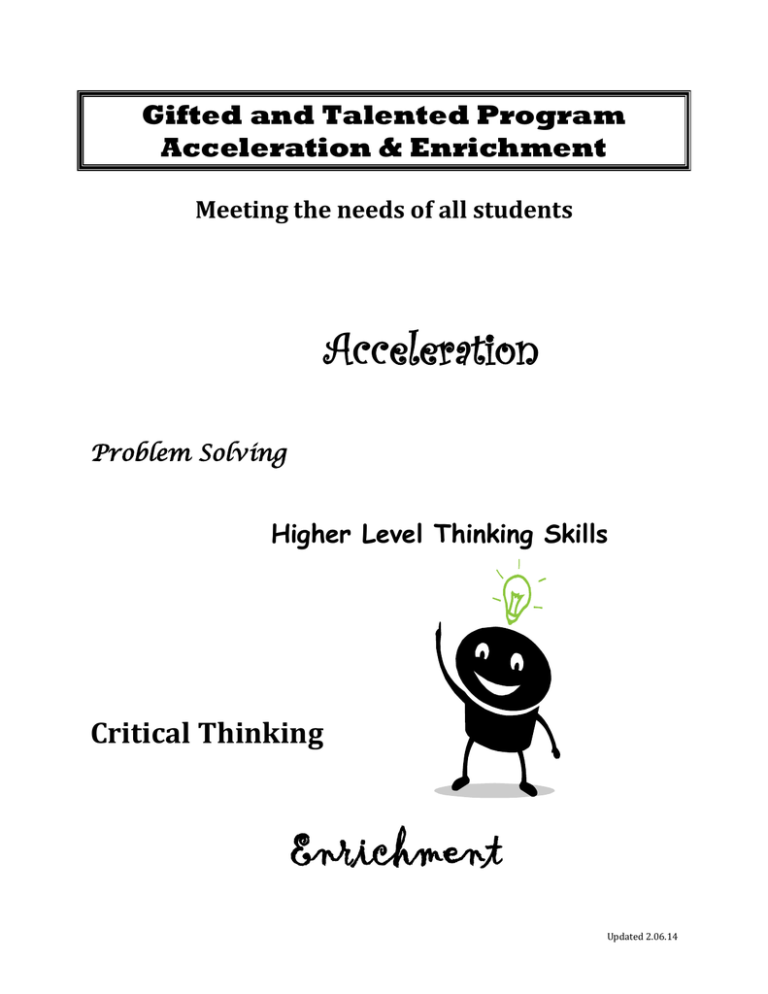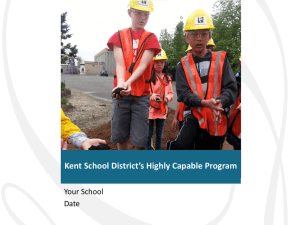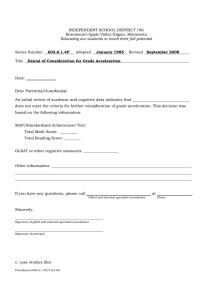Acceleration Enrichment Critical Thinking
advertisement

Gifted and Talented Program Acceleration & Enrichment Meeting the needs of all students Acceleration Problem Solving Higher Level Thinking Skills Critical Thinking Enrichment Updated 2.06.14 Definition Student – The gifted child possesses an early aptitude for abstract thinking. These children tend to demonstrate high level thought processes, i.e., the ability to see patterns, identify and consider multiple solutions, make valid generalizations, share insightful observations, in addition to drawing logical conclusions. The demonstration of academic potential appears in a multitude of areas, which allows the gifted child to consistently take in complex information and conceptual data beyond grade level expectations. These children are intuitive learners who need little or no explanation, but seem to learn effortlessly. Purpose – To provide a sufficient academic challenge in order to require growth. District 158 Philosophy for Gifted Programming District 158 is committed to an educational vision that recognizes the value, needs, and talents of each child and strives to assist the child in reaching his/her full potential. The District recognizes and identifies the unique needs and abilities of students and provides services and appropriate educational experiences that optimize each student’s individual development. Gifted and Talented students require a program that takes into consideration their potential for superior achievement. District 158 recognizes the diverse academic and social/emotional needs of the gifted child. In response to these needs, the Gifted and Talented Program strives to provide a curriculum which is differentiated in pace, depth and content level, and in which both enrichment and acceleration are the norm. Through a differentiated and accelerated curriculum and academic environment, the Gifted and Talented Program works to foster within the student’s desire for academic excellence, the confidence to take risks, a sense of responsibility, and a healthy self-concept. The program challenges students to translate potential into performance. What do the terms “Gifted and Talented” mean? National Association for Gifted Students – Students who have cognitive abilities significantly above the norm and/or who have demonstrated an exceptional aptitude or talent are considered gifted and or talented. They thrive on complexity and depth and need the abstract thinking approach to learning used in gifted education classes. Here are some additional references that have been used in the gifted community at large: August 1971 Congressional Report – Gifted and talented children are those identified by professionally qualified people who by virtue of outstanding abilities are capable of high performance. These are children who require differentiated educational programs and/or services beyond those normally provided by the regular school program in order to realize their contribution to self and society. The Gifted and Talented Program identifies and serves children with gifted intellectual ability (high level thought processes, divergent and abstract thinking) and highly exceptional ability in math and/or language arts. The students are identified using a matrix and through final determination by the Gifted and Talented Coordination Committee. For more information regarding the specifics of the matrix or procedures for admittance into the program please contact Denise Kuchta at dkuchta@district158.org. Page 2 Rationale for a Gifted and Talented Curriculum If success as an adult is dependent on the ability to put forth effort, to be persistent, be organized, goal oriented, and a problem solver, then… We must consider that these traits are only developed when the answers are not easily accessible; To the degree that gifted and talented students are different from their peers, they need a different set of interventions to get them to work and grow academically; The gifted and talented curriculum is not designed to give some students an advantage, but to provide an equal opportunity to develop potential and skills for success. Beliefs for Curriculum Development Learning occurs at a different pace, depth and style for children, including gifted students. A curriculum modified in level of content, depth, and pace is necessary for gifted students in their area(s) of strength. Abstract ideas and complex issues are consistently grasped and extended by gifted students in a deeper, broader manner than by their age-mates. Gifted students need opportunities to learn with other gifted students as well as with other age-mates. There is a need for support services to assist with the social/emotional development of gifted students. Students need to have their gifts recognized, supported, and properly challenged as early as demonstrated. Gifted students are often asynchronous in the development or demonstration of their abilities and require appropriate modification to challenge and grow academically. Gifted students need teachers trained in gifted education and approved by the State of Illinois as teachers of the gifted. All staff needs on-going staff development in the area of gifted education. What does the Gifted and Talented Program Offer The District 158 Gifted and Talented Program has three stages: 1. Elementary School Students who qualify will be placed with a gifted trained teacher. They will be clustered with students of similar abilities, as well as peers who are not in the program. All gifted students will be challenged at their level in areas they are identified for, as well as other core subjects as opportunities arise. The curriculum can be accelerated, lending time for deeper understanding and enrichment when necessary. Students in the program will be monitored to ensure success and growth. Page 3 2. Middle School Students who qualify for the middle grades Gifted and Talented Program will be placed in courses that best fit their identification. This will vary by student and individual needs in reading, mathematics, and the sciences. Students in the program will be monitored to ensure success and growth. 3. High School Students will make course selections based on academic need, possible career pathway, and interest. Students will be encouraged to explore self-goals and global awareness. Curriculum Designing Process Our work in curriculum consists of: Analyzing learner characteristics Analyzing the standard curriculum Reviewing best practices for the Gifted Learner Modifying learner objectives relative to content, product, process, and environment Documenting student growth Developing content and performance outcomes by grade level and subject Designing assessment that will document academic success relative to outcomes Reviewing the standard curriculum as it changes through the District’s committee processes Refining goals and objectives based on student performance and updated standard curriculum Utilizing summer curriculum work as a team to consistently update parts of the curriculum Elements of Differentiation Global view of curriculum includes rationale, the “big picture”, and a universal theme Pace is quicker – less time on drill and practice; use of compacting Thinking is more demanding – more analysis, synthesis, evaluation Content is complex, based on issues, problems, and/or themes Level of content needs to be challenging for the student in order to require growth Classroom environment assures psychological safety by having similar students grouped together with teachers trained in gifted education Psychological safety provides an arena where students are not embarrassed to excel, to have unusual perspective, or not get it right the first time Page 4 Goals for Identified Students 1. As a result of participation in the Gifted and Talented Program, students will demonstrate growth in achievement in their area(s) of strength. 2. The Gifted and Talented Program requires students to grow in academic effort, persistence, organizational skills, academic risk-taking, independence, interpersonal skills, and tolerance for ambiguity and behaviors of critical and creative thinking skills. Program Impact on all students: 1. Through assistance and encouragement from teachers and staff, all students will have opportunities to explore talent and develop thinking skills. 2. The Program Coordinator will be available to collaborate with classroom teachers in providing appropriate academic challenges for all children through differentiation strategies. Beliefs About Testing and Identification 1. Since aptitude testing is normed based on age, older children at a grade level do not have an advantage, and younger children are not penalized. 2. Numbers or percentages of our population do not drive our program, but by students who fit the program definition and demonstrate the need for a differentiated curriculum. 3. Classroom modifications for all children (i.e., enrichment, thinking skills instruction, compacting) are determined by individual student. performance, not the identification process. 4. No child is placed in our program without objective data and professional judgment that supports the placement. What measures are used for testing a student for the Gifted and Talented Program? District 158 uses 3 different measurement tools to assess students: Standardized Testing: OLSAT 8 or CoGAT is used to gain a student’s ability level for both verbal and non-verbal Local Testing: NWEA/MAP is used to find a trend in student’s content knowledge for both Reading and Mathematics Teacher Evaluation When can a student be tested for the Gifted and Talented Program? The OLSAT 8 Test is administered to ALL 2nd and 5th grade students in the Winter. All 2nd and 5th grade students are evaluated for the program. Re-Evaluations a. Students must wait a full year to be retested for the program due to content and familiarity of questions. Students can be referred by teachers, administrators, and parents alike for this process. Page 5 b. There are 2 times per year when a student can be retested: i. May 15 – June 15 or November 15 – December 15 ii. New students to the District can be tested upon request at registration or shortly thereafter Can a student be taken out of gifted programming? Each of the three stages of gifted programming run separate from one another. Students must place into each by the identification process. If a student is struggling in the gifted program, parents will be notified by the classroom teacher, the Gifted Coordinator, or school principal. A meeting will be held to discuss any concerns there may be at the time. A plan will be put in place to better serve the child. Our goal is to target each child’s needs and help them to develop at a rate for which they will be the most successful. What Does Enrichment Look Like? Critical Thinking: Critical thinking is making judgments. It includes using criteria to make decisions, supporting a position with evidence, identifying attributes for classification, drawing conclusions based on logic, identifying cause and effect relationships, inferring information from evidence, sequencing events or information, predicting outcomes based on patterns, and making appropriate generalizations. Creative Thinking: Creative thinking is creating new ideas. It includes designing unique and relevant products, creating alternatives, having an original perspective, elaborating or adding detail, expressing novel answers, creating new combinations, being driven by curiosity, hypothesizing, and tolerating ambiguity. Problem Solving: Problem solving uses critical and creative thinking. In solving any kind of problem, we use critical thinking to analyze its components and creative thinking to generate good solutions. Page 6 LANGUAGE ARTS CHARACTERISTICS AS THEY RELATE TO CURRICULUM DESIGN Specific Learner Characteristics Curriculum Modifications that Match the Student Engages in abstract thinking. Exposures to materials that require inferences, judgments, supporting position, intuition and predictions. Sees relationships, patterns, and makes generalizations about a large storehouse of information. Exposure to a wide variety of reading and writing experiences. Makes insightful observations. Exposure to literature and writing that uses symbolism, satire and other subtleties. Asks complex questions, generates new alternatives and answers. Environments that foster inquiry and psychological safety for the pursuit of answers and expression of self. Uses high level of language development in reading and writing. Encounters with increasingly difficult vocabulary and rules of language for further analysis. Senses consequences and can explain inconsistencies and subtle injustices. Exposure to thought provoking literature dealing with moral dilemmas, injustices and difficult social issues. Speaks with an adult-like vocabulary and sophisticated language structure. Opportunities to discuss issues with others with like abilities. Follows complex oral or written directions. Opportunities to work more independently Page 7 MATH CHARACTERISTICS AS THEY RELATE TO CURRICULUM DESIGN Specific Learner Characteristics Curriculum Modifications that Match the student Understands complex processes and concepts. Opportunities to explore underlying ideas, and conceptual frameworks beyond the facts. Sees discrepancies, probes for more data. Encounters with teachers. Applies math to daily problem solving has a logical approach. Exposures to real life situations where math can be applied and logic is needed. Performs difficult math problems intuitively. Opportunities to learn math through problem solving at a challenging level. Thinks and learns at an accelerated pace compared to peers. Opportunities to learn math at a pace that keeps even the brightest students involved. Sees patterns, makes generalizations, draws conclusions. Exposures to situations that require inductive/deductive reasoning. Generates alternatives, discovers new approaches. Exposures to inquiry method, and opportunities for discovery. Explains math, has good reasoning and number sense. Opportunities to talk about math and demonstrate answers. Page 8 Sites for Kids: www.playkidsgames.com www.funbrain.com www.aaamath.com www.primarygames.com/reading.htm www.mathplayground.com www.aplusmath.com Sites for Parents: www.sengifted.org www.chicago.us.mensa.org www.hoagiesgifted.org www.giftsforlearning.com www.thegiftedchild.net Page 9




